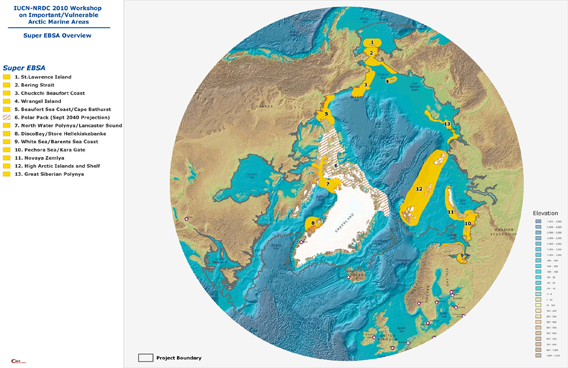
Map showing the 13 most vulnerable areas in the Arctic marine environment. Photo: IUCN/NRDC. Click image to enlarge.
Two major threats face the Arctic: the first is global climate change, which is warming the Arctic twice as fast the global average; the second is industrial expansion into untouched areas. The oil industry is exploring new areas in the Arctic, which they could not have reached before without anthropogenic climate change melting the region’s summer ice; but, of course, the Arctic wouldn’t be warming without a hundred years of massive emissions from this very same industry, thus creating a positive feedback loop that is likely to wholly transform the Arctic. In addition, new shipping routes and greater fishing pressure are expected in recently accessible areas. Now, a report from the Natural Resources Defense Council (NRDC) and the International Union for the Conservation of Nature (IUCN) have selected 13 areas of Arctic they argue deserve protection given their ecological importance and vulnerability.
“There is increasing interest in expanded economic activities in the Arctic,” Thomas L. Laughlin, Deputy Head of IUCN’s Global Marine and Polar Program, said in a press release. “The information and maps we have available now will allow governments and the international community to make the right choices regarding the conservation and use of the natural resources of the Arctic.”
In total the report finds 77 areas that deserve consideration for protection, however it points to 13 that especially stand out. These 13 sites include: St. Lawrence Island, Bering Strait, and Wrangell Island, the Chukchi Beaufort Coast, Beaufort Coast/Cape Bathurst, Polar Pack Refugium, Lancaster Sound/North Water Polynya, Disko Bay/Store Hellefiskebanke, White Sea/Barents Sea Coast, Pechora Sea/Kara Gate, Novaya Zemlya, High Arctic Islands and Shelf, and the Great Siberian Polynya.
The Arctic wide report was crafted during a workshop last year involved 34 scientists and representatives from Arctic indigenous communities.
“We have a short window of opportunity to plan for industrial development in a way that respects and protects important and fragile ocean places, wildlife and communities. As nations around the Arctic plan new offshore oil development, fishing and shipping, this report jumpstarts the process of identifying areas that should be considered for protection from the environmental consequences of those activities, including oil spills, pollution, and habitat degradation,” Lisa Speer, Director of the International Oceans Program at NRDC, said.
Related articles
Arctic sea ice maximum ties for lowest on record
(03/24/2011) Providing more data on how climate change is impacting the Arctic, the maximum extent of sea ice this year was tied with 2006 for the lowest on record. Maximum sea ice simply means the territory the sea ice covers at its greatest point before the seasonal melt begins.
Arctic fish catch vastly underreported (by hundreds of thousands of metric tons) for 5 decades
(02/07/2011) From 1950 to 2006 the United Nation Food and Agriculture Agency (FAO) estimated that 12,700 metric tons of fish were caught in the Arctic, giving the impression that the Arctic was a still-pristine ecosystem, remaining underexploited by the world’s fisheries. However, a recent study by the University of British Colombia Fisheries Center and Department of Earth and Ocean Sciences throws cold water on this widespread belief. According to the study, published in Polar Biology, the total Arctic catch from 1950 to 2006 is likely to have been nearly a million metric tons, almost 75 times the FAO’s official record.
Disappearance of arctic ice could create ‘grolar bears’, narlugas; trigger biodiversity loss
(12/22/2010) The melting of the Artic Ocean may result in a loss of marine mammal biodiversity, reports a new study published in the journal BNature and conducted jointly by the National Oceanic and Atmospheric Association (NOAA), the University of Alaska, and the University of Massachusetts. The study is the first to project what might happen if species pushed into new habitats because of ice loss hybridize with one another, resulting in such crossbreeds as “narlugas” and “grolar bears”.














